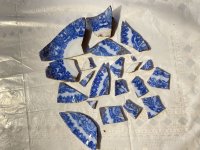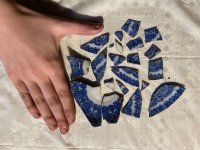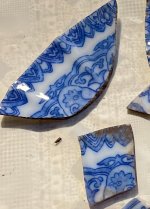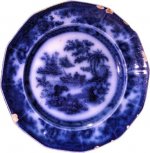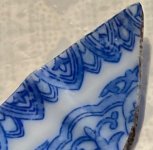MountainThrifts
Tenderfoot
- Jan 3, 2021
- 5
- 3
- Primary Interest:
- All Treasure Hunting
I’ve found another big find! Though yet again I am stuck on what it could be! �� At first I thought it was a plate because I found so many pieces of it! But after trying to piece it together like a puzzle I noticed the bottom rim of two of the pieces are pretty small. This now makes me think it is either a bowl, tea cup saucer, or another item in similar size.
I’m pretty sure no one could figure out what the item actually was, and so I’m looking at the pattern for help! I found it very funny there were four chicken heads staring back at me!! (Two of them had parts cut off, the poor things XD)
I’m nearly certain the color is “Flowing Blue”. It’s called that for a reason! When these were first made the color would run and stain the items due to the structure of the paint itself. Eventually they fixed this error and very few originals remain today, they’re really rare and sell for good money. If I ever found one I wouldn’t let it out of my sight haha, but anyways, getting back on track.
I will search for the design myself but I’m curious if anyone here already knows about it! Last time I posted I got an awesome response within a few hours! So if anyone knows anything about this item’s design origin please let me know!
Photos attached below, but I can never get it to work easily on mobile so if they aren’t there I’ll try to fix that soon ����
I’m pretty sure no one could figure out what the item actually was, and so I’m looking at the pattern for help! I found it very funny there were four chicken heads staring back at me!! (Two of them had parts cut off, the poor things XD)
I’m nearly certain the color is “Flowing Blue”. It’s called that for a reason! When these were first made the color would run and stain the items due to the structure of the paint itself. Eventually they fixed this error and very few originals remain today, they’re really rare and sell for good money. If I ever found one I wouldn’t let it out of my sight haha, but anyways, getting back on track.
I will search for the design myself but I’m curious if anyone here already knows about it! Last time I posted I got an awesome response within a few hours! So if anyone knows anything about this item’s design origin please let me know!
Photos attached below, but I can never get it to work easily on mobile so if they aren’t there I’ll try to fix that soon ����
Attachments
Last edited:


